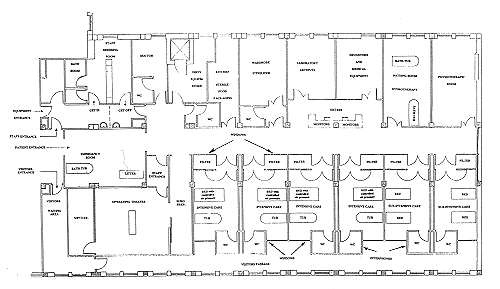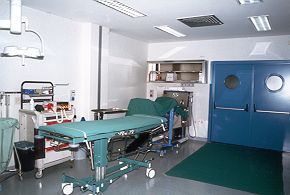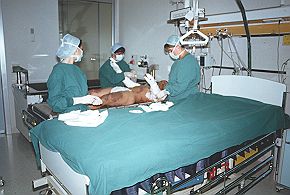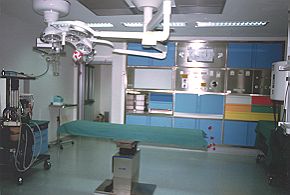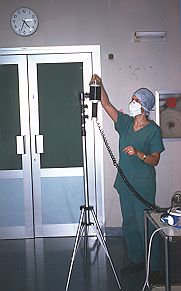Annals of Burns and Fire Disasters - vol. XII - n° 4 - December 1999 TRENDS AND STRATEGIES FOR INFECTION CONTROL IN A NEW BURNS CENTREMelandri D, Morri M, Polverelli M, Pierleoni M, Arcangeli F, Landi G. Division of Dermatology and Burns Centre, M. Bufalini Hospital, Cesena, Italy SUMMARY. Despite the significant advances made in the last 40 years in the treatment of burn patients, infections continue to represent a serious complication of burn injuries and a stimulating challenge for medical staff. The general arrangement of a new burns centre in Cesena was carefully planned in order to achieve a significant reduction in the risk of infection and to keep the microbial environment to a minimum. Special architectural structures were used to achieve satisfactory isolation from the external environment. There are separate entrances for burn unit staff, patients, equipment, and visitors. Air-handling systems have been installed, with a larninar airflow room and the choice of multiple centralized air-conditioning units for patients, staff, and the operating theatre. All rooms are provided with a bath in order to minimize the risk of cross-infection, which is traditionally associated with hydrotherapy. For the same reason, all rooms have an anteroom that functions as a further filter area for the staff. Microbiological checks are carried out on a frequent basis both on air samples and on surface swabs in order to monitor the level of microbial contamination inside the unit. Introduction
The purpose of this paper is to focus on the principles that were followed in the planning this new Burns Centre in order to prevent the spread of infection. In particular, we intended to verify whether microbial control of the environment is an effective measure in this respect. Material Results Discussion
Each room is equipped with
an extensively glazed anteroom provided with sterile equipment and a sink. This functions
as a further filter area: before entering the room to perform the daily dressings, staff
put on a sterile jacket and a pair of gloves that they remove before leaving the anteroom.
Multiple centralized
air-conditioning units guarantee different conditions of temperature, humidity, and
positive air pressure for the different areas of the Burns Unit. The operating theatre and
the patient area also have laminar low-speed air flow. The whole air-handling system
mobilizes 15,000 cubic metres of air per hour, with a complete air exchange every three
minutes in the operating theatre, every four in the intensive care rooms, and every twelve
in the remaining areas of the Centre.
We did this on a recent occasion and subsequent checks showed a significant reduction in air microbial contamination. It may therefore be advisable to replace filters more frequently than recommended by the manufacturers. The use of disposable items could be another appropriate measure to adopt if disinfection procedures in reusable articles (e.g. sponges and towels for cleansing) do not produce adequate results. Conclusion RESUME. Malgré les progrès significatifs réalisés dans les derniers quarante ans dans le traitement des patients brûlés, les infections continuent à représenter une grave complication des lésions et une stimulation pour le personnel médical. Pour réduire en manière significative le risque des infections et pour maintenir aux valeurs minimales les niveaux microbiens de l'environnement, les Auteurs ont projeté selon des critères particuliers l'arrangement général d'un nouveau Centre des Brûlés à Césène en Italie. Ils ont employé des structures architecturales spécifiques pour réaliser un isolement efficace de l'environnement externe. Il y a des entrées séparées pour le personnel du Centre, les patients, le matériel et les visiteurs. Le Centre possède des systèmes d'aération, avec une salle de circulation laminaire de l'air et un choix d'unités centralisées multiples de climatisation pour les patients, le personnel et la salle d'opération. Pour minimiser le risque des infections croisées, associées traditionellement à la technique de l'hydrothérapie, toutes les chambres sont dotées d'un bain. Pour la même raison toutes les chambres ont une antichambre qui agit comme zone ultérieure de filtration pour le personnel. Des contrôles microbiologiques sont effectués fréquemment, soit sur les échantillons d'air soit sur les tampons des surfaces brûlées, pour contrôler le niveau de la contamination microbienne dans le Centre. BIBLIOGRAPHY
|
